get in touch (254)-233-8435
Choosing the perfect Mobile Home Skirting Materials
Discover the best mobile home skirting options to enhance curb appeal and energy efficiency. Learn about various materials, installation tips, and cost considerations to find the perfect solution for your mobile home. Upgrade your home's look and function today!
MOBILE HOME SKIRTING
1/2/20246 min read


What is Mobile Home Skirting and why does it matter
Mobile home skirting is a protective covering that conceals the underbelly of your mobile home, transforming its appearance and enhancing its functionality. Not only does it provide a polished, finished look, but it also plays a vital role in safeguarding your home from the elements. By shielding your home from wind, snow, rain, and extreme temperatures, skirting helps maintain a comfortable interior environment and reduces energy costs. Additionally, it acts as a barrier against pests and rodents, ensuring a pest-free living space.
Why Mobile Home Skirting Matters: A Closer Look
Mobile home skirting is a smart investment that offers numerous benefits:
Weather Protection: Shield your home from harsh weather conditions, including wind, rain, snow, and extreme temperatures. Skirting creates a barrier that prevents moisture and cold air from seeping into your home, ensuring a comfortable and dry living environment.
Energy Efficiency: Reduce your energy bills significantly. By sealing off the space beneath your home, skirting minimizes heat loss in winter and heat gain in summer. This allows your HVAC system to work more efficiently, saving you money on energy costs.
Pest Prevention: Keep unwanted pests at bay. Skirting acts as a barrier, preventing rodents, insects, and other critters from accessing your home's undercarriage. This helps maintain a clean and healthy living space.
Enhanced Aesthetics: Transform your mobile home's appearance. Skirting adds a finished look to your home, making it more visually appealing and increasing its curb appeal. You can choose from a variety of materials and styles to match your personal taste and home's exterior.
Structural Support: Provide additional support to your home's structure. While skirting is not a primary load-bearing component, it can help protect your home's undercarriage from damage caused by wind, rain, and other environmental factors.
By investing in mobile home skirting, you're making a wise decision that will benefit you for years to come
Choosing the Perfect Skirting for Your Mobile Home
Tailoring Your Skirting to Your Needs: From durable vinyl to stylish wood, there's a skirting material to suit every mobile home owner. Consider factors like climate, budget, and personal preference when making your selection:
Vinyl Skirting: A Durable and Affordable Choice for Mobile Homes
Vinyl skirting is a popular choice for mobile home owners due to its numerous advantages:
Affordability: Vinyl is a budget-friendly option that offers excellent value for money.
Durability: Vinyl is a long-lasting material that can withstand harsh weather conditions.
Low Maintenance: Vinyl requires minimal upkeep, making it a practical choice for busy homeowners.
Versatile Styling: Available in a wide range of colors and textures, vinyl skirting can complement any home's exterior.
Easy Installation: Vinyl is relatively easy to install, making it a DIY-friendly option.
While vinyl is a fantastic choice, it's important to note that it may be susceptible to cracking or warping in extreme weather conditions. However, with proper installation and maintenance, vinyl skirting can provide years of reliable performance.
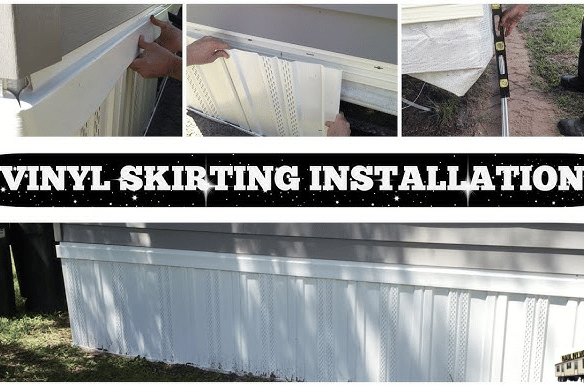

Metal Skirting:
Metal skirting is a more durable option, often made from materials like aluminum or galvanized steel. It offers excellent protection against pests and the elements, and it can last for many years with proper maintenance.
Pros: Extremely durable, resistant to pests and weather, low maintenance.
Cons: More expensive than vinyl, can rust over time if not properly maintained, limited color options.
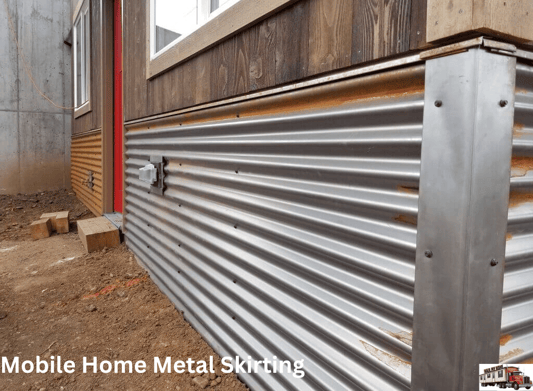

Concrete Skirting:
For those looking for a more permanent solution, concrete skirting is an excellent choice. It provides a solid barrier that can withstand harsh weather conditions and offers superior protection against pests.
Pros: Very durable, fire-resistant, excellent protection from weather and pests.
Cons: Expensive, difficult to install, requires professional installation.
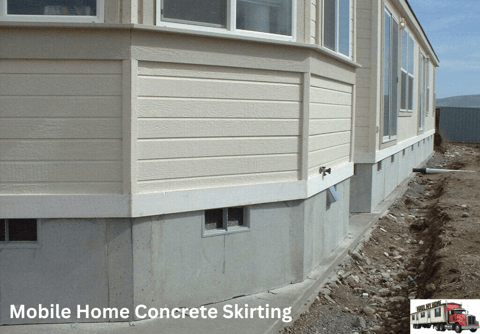

Brick and Masonry Skriting:
Brick and masonry skirting gives a traditional and upscale appearance to mobile homes. It is very durable and provides excellent insulation, making it a great choice for homes in colder climates.
Pros: Highly durable, excellent insulation, attractive appearance.
Cons: Very expensive, requires professional installation, and time-consuming to install.
Mobile Home Latice Skirting
Lattice skirting is an aesthetically pleasing option that is often used as an accent rather than full skirting. It allows for ventilation and is typically made from wood or vinyl.
Pros: Attractive appearance, allows for ventilation, easy to install.
Cons: Not very durable, provides minimal protection against the elements and pests.
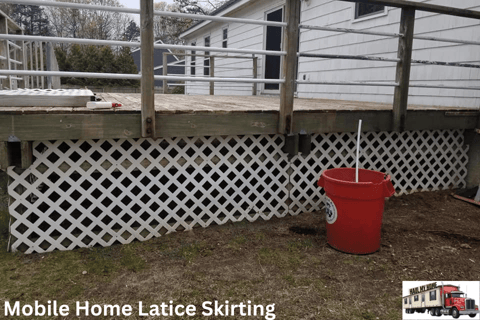

Mobile Home Simulated Rock Skirting:
Mobile Home Simulated rock skirting is designed to mimic the appearance of stone or rock. It offers a high-end look without the high-end price and can be a great way to enhance the curb appeal of your mobile home.
Pros: Attractive, realistic appearance, durable, relatively easy to install.
Cons: More expensive than vinyl, may not be as durable as real stone.
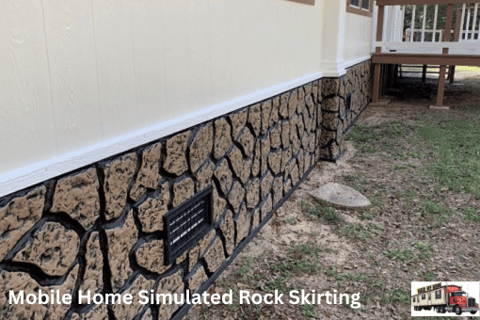

Choosing the Best Mobile Home Skirting for Your Home
Selecting the right mobile home skirting material depends on various factors, including your budget, climate, and personal preferences. Here are some tips to help you make the best choice:
Consider the Climate: The climate in your area should heavily influence your choice of mobile home skirting. For example, if you live in an area with extreme weather conditions, you might want to consider more durable options like metal or concrete skirting.
Budget: Mobile home skirting is available at various price points. Vinyl skirting is typically the most affordable option, while brick and masonry skirting is on the higher end of the cost spectrum. Be sure to factor in not just the initial cost but also the long-term maintenance costs.
Aesthetic Appeal: Your skirting should complement the exterior of your home. If you’re looking for a more traditional appearance, brick or simulated rock skirting might be the best option. For a modern look, vinyl or metal skirting could be ideal.
Maintenance: Consider how much time and effort you’re willing to put into maintaining your skirting. Vinyl skirting requires little maintenance, while options like wood or metal may require more upkeep to prevent damage.
Installation: Some mobile home skirting materials are easier to install than others. If you’re planning a DIY project, you might want to choose a material that is lightweight and easy to work with, like vinyl or foam skirting.
How to install Mobile Home Skirting
Installing mobile home skirting can be a DIY project if you have the right tools and materials. Here’s a step-by-step guide to help you through the process:
Step 1: Gather Your Materials
Before you begin, make sure you have all the necessary materials and tools. This includes skirting panels, top and bottom tracks, ground spikes, a level, a saw, and a drill.
Step 2: Measure Your Mobile Home
Measure the perimeter of your mobile home to determine how much skirting you will need. Be sure to account for any doors, vents, or other openings.
Step 3: Prepare the Ground
The ground around your mobile home should be level and free of debris. If necessary, you can use gravel to create a more stable base for your skirting.
Step 4: Install the Bottom Track
The bottom track will hold the skirting panels in place. Use ground spikes to secure the track to the ground, making sure it is level.
Step 5: Install the Top Track
Attach the top track to the bottom of your mobile home. This track will secure the top of the skirting panels. Make sure it is level and securely fastened.
Step 6: Cut and Install the Skirting Panels
Measure and cut the skirting panels to the appropriate height. Slide the panels into the bottom track and secure them with screws at the top. Be sure to leave room for ventilation and access panels where needed.
Step 7: Install Vents and Access Panels
Vents are essential for preventing moisture buildup under your mobile home. Install vents according to the manufacturer’s instructions. Additionally, you should install access panels for maintenance purposes.
Step 8: Inspect Your Work
Once the skirting is installed, inspect it for any gaps or loose panels. Make sure everything is secure and properly aligned.
Maintaining your Mobile Home Skirting
Proper maintenance of your mobile home skirting is essential to ensure its longevity, effectiveness, and continued protection of your home. While mobile home skirting is designed to withstand various environmental conditions, regular upkeep will help prevent potential issues and extend the lifespan of the material.
Here are some tips and best practices for maintaining your mobile home skirting:
1. Regular Inspections
2. Cleaning Your Mobile Home Skirting
3. Repairing and Replacing Damaged Panels
4. Ventilation Maintenance
5. Pest Prevention
Ultimately, investing in quality mobile home skirting and adhering to best maintenance practices will help you protect your investment, enhance your home's comfort and efficiency, and maintain its curb appeal. Whether you're upgrading existing skirting or installing new, this guide provides the knowledge and tools you need to make informed decisions and enjoy the full benefits of a well-maintained mobile home.
Services
Contact
Privacy
info@haulmyhome.com
(254)-233-8435
© 2024. All rights reserved. Haul My Home
